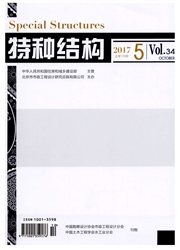

 中文摘要:
中文摘要:
弹塑性反应谱是基于性能抗震设计理论中的基础性课题之一,而场地条件对反应谱的影响情况,以及如何确定场地影响在规范设计反应谱中的体现形式,是目前工程抗震领域研究和讨论的热点问题。本文将三种场地类别上的1217条强震记录,按照场地条件和地震动峰值加速度分为21组,对两自由度体系的基础隔震结构简化模型作弹塑性时程分析,研究场地类别对基础隔震结构弹塑性加速度反应谱的影响。研究表明,结构的加速度响应依赖于场地类别,在基础隔震结构的自振周期范围内,结构的弹塑性加速度反应谱的谱值随场地土变软而增大。采用平均化的方式研究了反应谱的特性,运用分段线性拟合的方法,建立了与场地类别相对应的基础隔震结构弹塑性加速度反应谱公式,并通过算例验证了该公式的准确性,可将其用于基础隔震结构的抗震设计中。
 英文摘要:
英文摘要:
Although the Elasto-plastic response spectra is one of the fundamental research in performancebased seismic design, the impact of site condition on the response spectra and how to determine the impact of the site in the design response spectra expression form are still the hot issues in engineering seismic research and discussion. In this paper, 1217 strong earthquake ground motion records on I ~III site were classified into 21 groups according to the site conditions and PGA. And the influence of site condition on acceleration response spectra of base-isolated structure were discussed, Based on elasto-plastic time history analysis for two degrees of freedom which is simplified by base-isolated structure. The results showed that the acceleration response of the structure depends on the site conditions, within the natural vibration range of the base-isolated structure, the value of elasto-plastic acceleration response spectra increases with the soil becoming softer. The features of the response spectra were studied by means of averaging, and the expressions of design response spectra were established by using piecewise linear fitting method. It can be reflected by the influence of site conditions for spectra. Meanwhile, the accuracy of the expression is verified by the seismic response of real base-isolated structure, and it can be used in the seismic design for base-isolated structures.
 同期刊论文项目
同期刊论文项目
 同项目期刊论文
同项目期刊论文
 期刊信息
期刊信息
